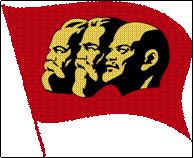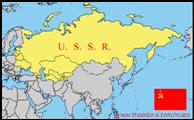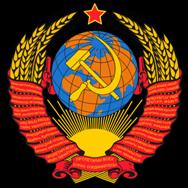|
USSR (U.S.S.R.) also called SOVIET UNION, Russian SOYUZ SOVETSKIKH SOTSIALISTICHESKIKH RESPUBLIK or SOVETSKY SOYUZ, Union of Soviet Socialist Republics: The Union of Soviet Socialist Republics.former northern Eurasian empire (1917/22-1991) stretching from the Baltic and Black seas to the Pacific Ocean and, in its final years, consisting of 15 Soviet Socialist Republics (S.S.R.'s)-Armenia, Azerbaijan, Belorussia (now Belarus), Estonia, Georgia, Kazakstan, Kirgiziya (now Kyrgyzstan), Latvia, Lithuania, Moldavia (now Moldova), Russia, Tajikistan, Turkmenistan, Ukraine, and Uzbekistan. The capital was Moscow, then and now the capital of Russia.During the period of its existence, the Union of Soviet Socialist Republics was by area the world's largest country. It was also one of the most diverse, with more than 100 distinct nationalities living within its borders. The majority of the population, however, was made up of East Slavs (Russians, Ukrainians, and Belorussians); these groups together made up more than two-thirds of the total population in the late 1980s.At its greatest extent, between 1946 and 1991 (the figures and descriptions given below refer to this period), the U.S.S.R. covered some 8,650,000 square miles (22,400,000 square kilometres), seven times the area of India and two and one-half times that of the United States. The country occupied nearly one-sixth of the Earth's land surface, including the eastern half of Europe and roughly the northern third of Asia.The U.S.S.R. extended more than 6,800 miles (10,900 kilometres) from east to west, covering 11 of the world's 24 time zones. The most westerly point was on the Baltic Sea, near Kaliningrad; the easternmost was Cape Dezhnev on the Bering Strait, nearly halfway around the world. From north to south the U.S.S.R. extended some 2,800 miles from Cape Chelyuskin to Kuskha on the Afghan border. Nearly half the territory of the U.S.S.R. was north of 60 N, at the same latitude as Alaska, Baffin Island, and Greenland.In addition to having the world's longest coastline, the U.S.S.R. had the longest frontiers. To the north the country was bounded by the seas of the Arctic Ocean, and to the east were the seas of the Pacific. On the south the U.S.S.R. was bordered by North Korea, Mongolia, China, Afghanistan, Iran, and Turkey. On the southern frontier there were three seas: the Caspian Sea, the world's largest inland sea, as well as the almost completely landlocked Black Sea and Sea of Azov. Romania, Hungary, Czechoslovakia, Poland, Finland, and Norway lay to the west.The U.S.S.R. was the successor to the Russian Empire of the tsars. Following the 1917 Revolution, four socialist republics were established on the territory of the former empire: the Russian and Transcaucasian Soviet Federated Socialist Republics and the Ukrainian and Belorussian Soviet Socialist Republics. On Dec. 30, 1922, these constituent republics established the U.S.S.R. Additional union republics (Soviet Socialist Republics) were set up in subsequent years: the Turkmen and Uzbek S.S.R.'s in 1924, the Tadzhik S.S.R. in 1929, and the Kazakh and Kirgiz S.S.R.'s in 1936. In that year the Transcaucasian Republic was abolished and its territory was divided between three new republics: the Armenian, Azerbaijan, and Georgian S.S.R.'s. In 1940 the Karelo-Finnish, Moldavian, Estonian, Latvian, and Lithuanian S.S.R.'s were established. The Karelo-Finnish S.S.R. became an autonomous republic in 1956, leaving a total of 15 union republics (soyuznye respubliki). In addition to these, the U.S.S.R. as of 1990 was made up of 20 autonomous republics (avtonomnye respubliki), 8 autonomous provinces (avtonomnye oblasti), 10 autonomous districts (avtonomnye okruga), 6 regions (kraya), and 114 provinces (oblasti).Under the constitution adopted in the 1930s and modified down to October 1977, the political foundation of the U.S.S.R. was formed by the Soviets (Councils) of People's Deputies. These existed at all levels of the administrative hierarchy, with the Soviet Union as a whole under the nominal control of the Supreme Soviet of the U.S.S.R., located in Moscow. This body had two chambers--the Soviet of the Union, with 750 members elected on a single-member constituency basis; and the Soviet of Nationalities, with 750 members representing the various political divisions: 32 from each union republic, 11 from each autonomous republic, 5 from each autonomous region, and 1 from each autonomous district. In elections to these bodies, the voters were rarely given any choice of candidate other than those presented by the Communist Party of the Soviet Union (CPSU), which, until the amendment of Article 6 of the constitution in March 1990, was the "leading and guiding force of Soviet society and the nucleus of its political system." In theory, all legislation required the approval of both chambers of the Supreme Soviet; in practice, all decisions were made by the small group known as the Presidium of the Supreme Soviet, itself strongly influenced by the Politburo of the CPSU, and were unanimously approved by the deputies. The role of the soviets in the individual republics and other territories was primarily to put into effect the decisions made by the Supreme Soviet of the U.S.S.R.The political system was thus authoritarian and highly centralized, and this also applied to the economic system. The economic foundation of the U.S.S.R. was "Socialist ownership of the means of production, distribution, and exchange," and the economy of the entire country was controlled by a series of five-year plans that set targets for all forms of production.Dramatic changes, both political and economic, occurred during the late 1980s and early '90s, ushered in by the adoption of perestroika ("restructuring") and glasnost ("openness"). On the economic side the planned, highly centralized command economy was to be replaced by the progressive introduction of elements of a market economy, a change that proved difficult to achieve and was accompanied by declining production in many sectors and increasing distribution problems. In the political sphere, amendments to the constitution in 1988 replaced the old Supreme Soviet with the Congress of People's Deputies of the U.S.S.R. The new congress had 2,250 members; one-third of these were elected on a constituency basis, one-third represented the political territories (as in the old Supreme Soviet), and the remaining third came from "all-union social organizations" such as the trade unions, the CPSU, and the Academy of Sciences. Voters were presented with a choice of candidates, and many non-Communists were elected. The Congress of People's Deputies elected a new Supreme Soviet of 542 members and also chose the chairman of that body, who was to be the executive president of the U.S.S.R. Congresses of People's Deputies were also established in each republic.These congresses could be legitimately described as parliaments, and they engaged in vigorous debate over the economic and political future of the country. From 1989, conflicts developed between the parliament of the U.S.S.R. and those of the individual republics, mainly over the respective powers of the centre (the U.S.S.R. government) and the republics. These conflicts were exacerbated by the resurgence of ethnic nationalism and increasing demands for autonomy and even for full independence. Following the abortive coup of August 1991, in which the CPSU was heavily implicated, the party itself was abolished.By December 1991 the Union of Soviet Socialist Republics had virtually ceased to exist, and the future of its territories and peoples was uncertain. Three republics--Estonia, Latvia, and Lithuania--had achieved complete independence and were internationally recognized as sovereign states, and several others were demanding independence. Attempts were made, led by Mikhail Gorbachev, the president of the Soviet Union, to establish a new "Union of Sovereign States" with some degree of integration in foreign policy, defense, and economic affairs, but agreement among the remaining 12 republics was not achieved. Whatever the legal position, the union republics had begun to act as if they were sovereign states and were negotiating with each other, bypassing the vestigial central government. This process culminated on Dec. 8, 1991, in the signing of an agreement between the three Slav republics of Russia, Ukraine, and Belarus for the establishment of the Commonwealth of Independent States (CIS), with an agreed common policy for foreign affairs and defense. The CIS later came to include all the remaining republics except Georgia, but great difficulty was experienced in arriving at agreed policies. The future thus remained uncertain, but there could be no disagreement with the statement by the leaders of the Commonwealth that "the U.S.S.R. has ceased to exist as a geopolitical reality." (J.C.D.)This article contains a history of the Union of Soviet Socialist Republics from 1917 to 1991. For the geography and history of the former Soviet Socialist republics, see the articles Moldova, Estonia, Latvia, Lithuania, Kazakstan, Kyrgyzstan, Tajikistan, Turkmenistan, Uzbekistan, Russia, Armenia, Azerbaijan, Georgia, and Ukraine. |




|
Soviet Union: Culture†† LINK |

